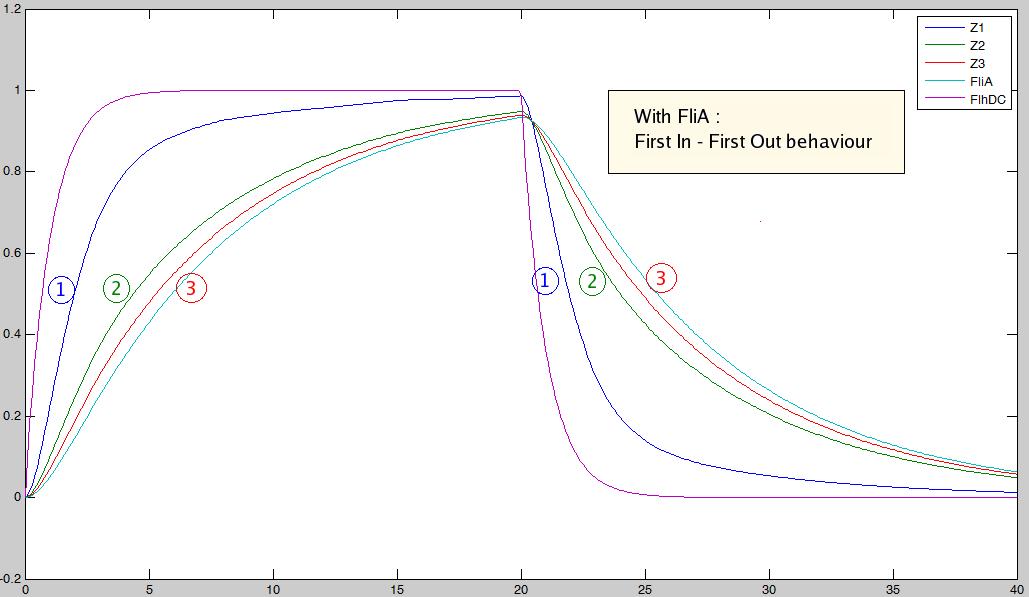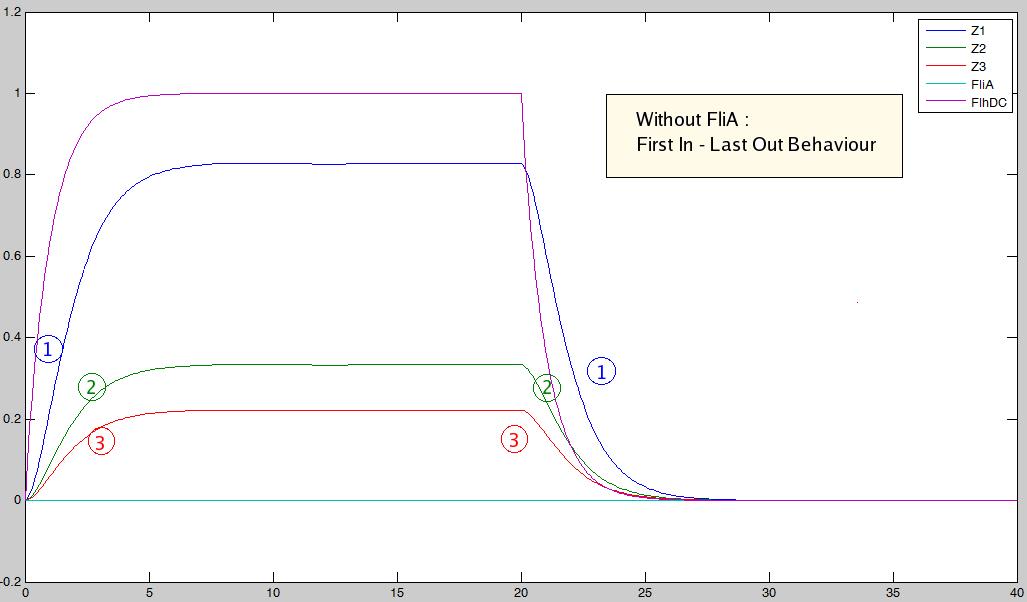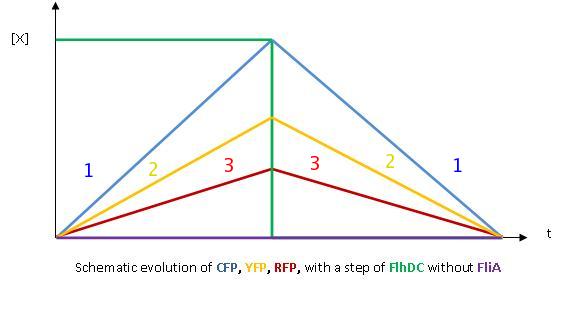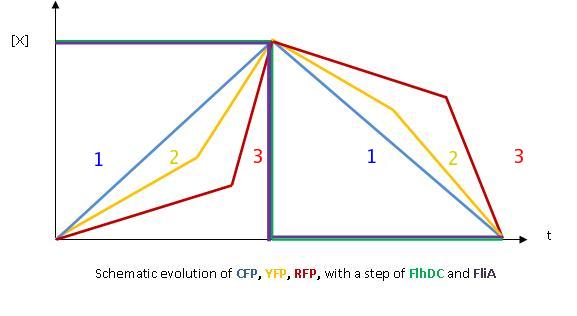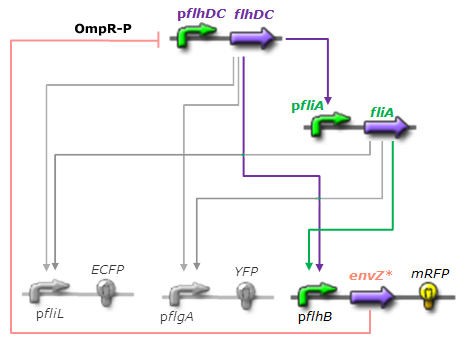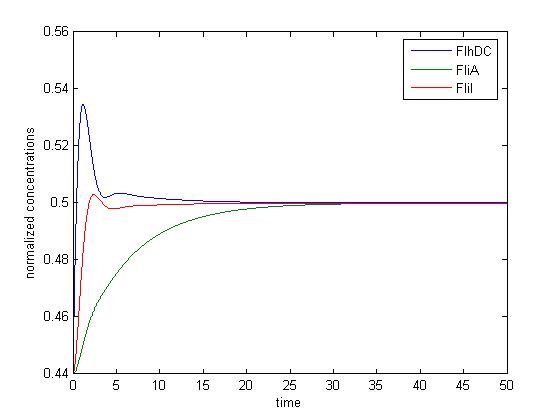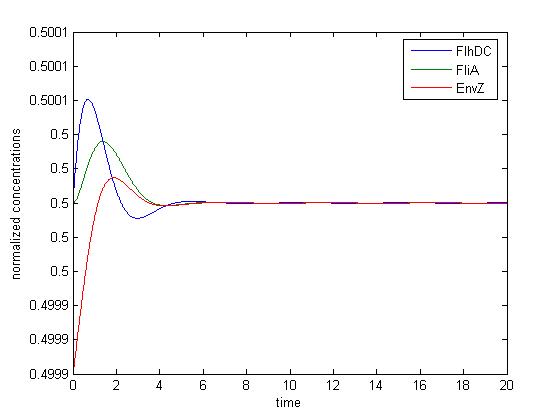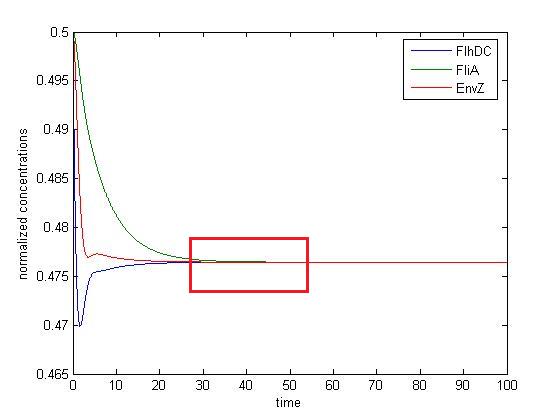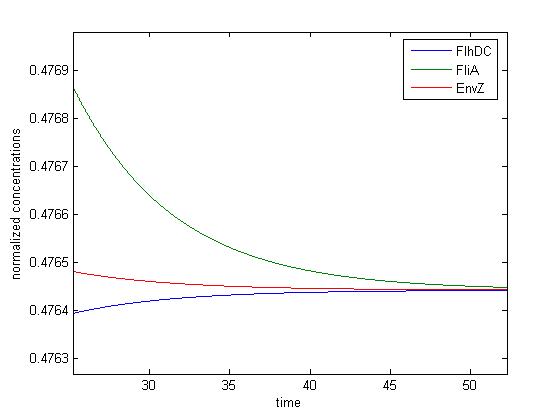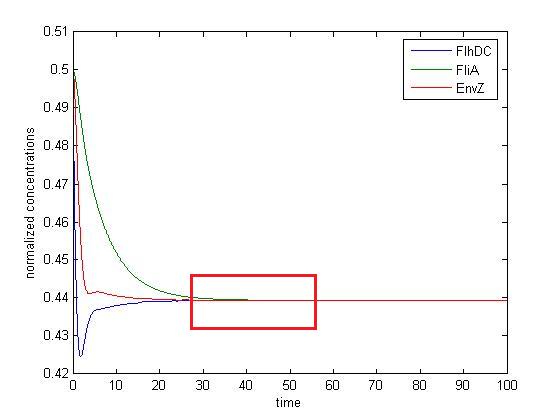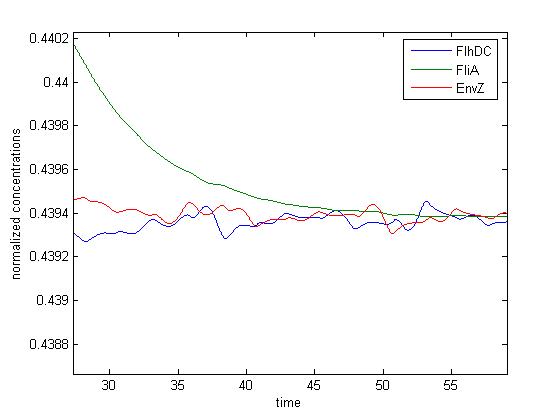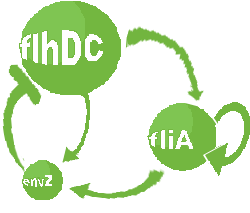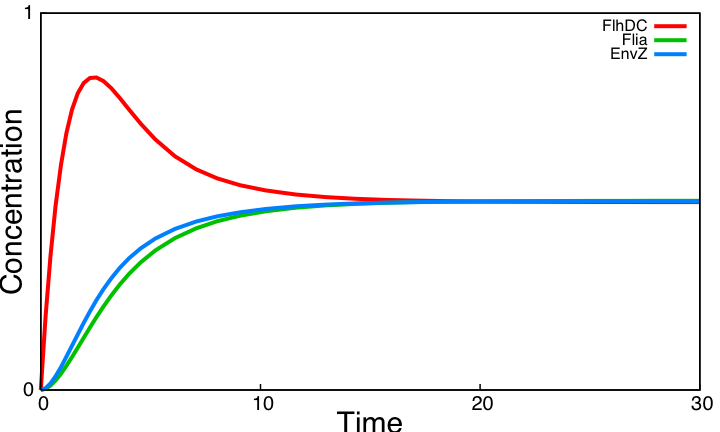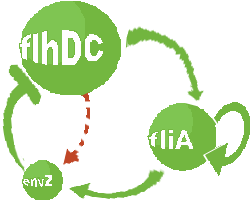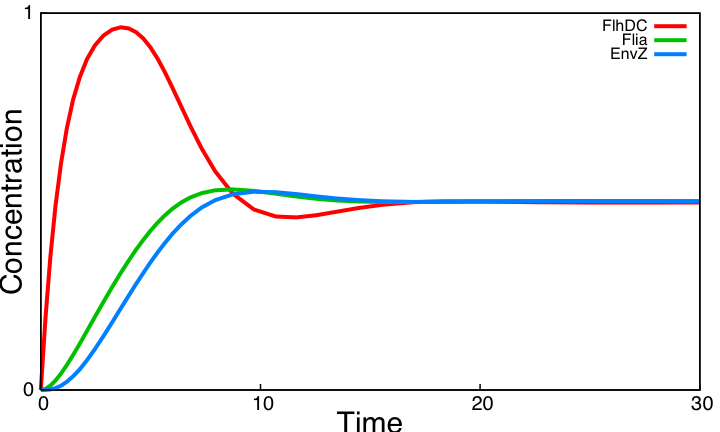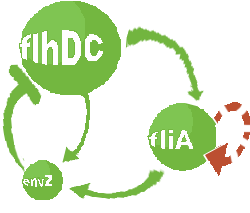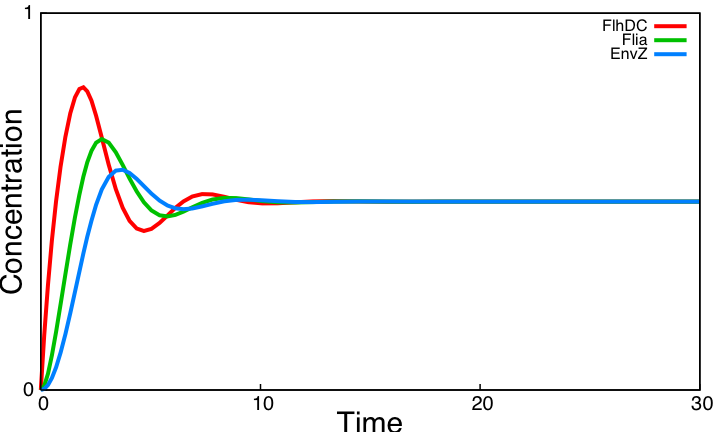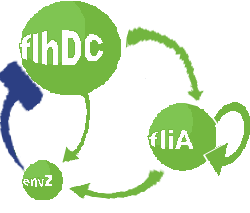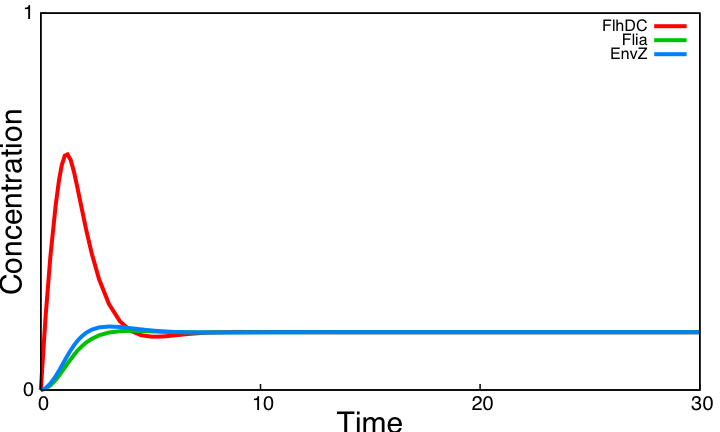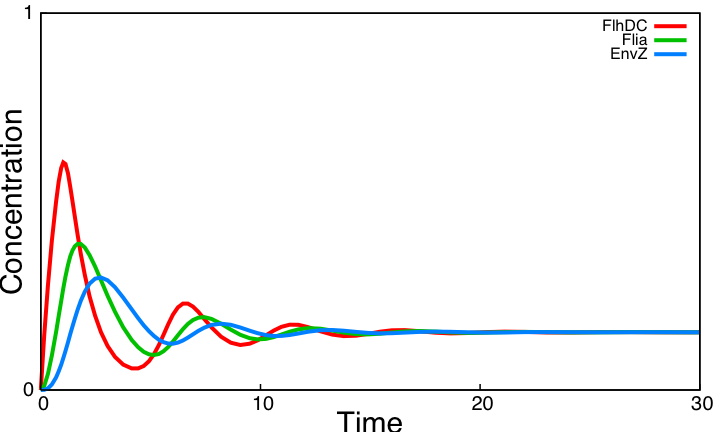Team:Paris/Analysis/Math+Sim
From 2008.igem.org
(→FIFO) |
(→Oscillations) |
||
| (92 intermediate revisions not shown) | |||
| Line 1: | Line 1: | ||
{{Paris/Menu}} | {{Paris/Menu}} | ||
| + | {{Paris/Header|Mathematical Analysis and Simulations}} | ||
| + | {{Paris/Section_contents_analysis}} | ||
| + | |||
| + | = FIFO = | ||
| + | * In order to go further into the details of mathematical analysis of the FIFO, let us remind you the genetic network that has been designed to produce a First In - First Out behaviour and the result of the corresponding model : | ||
<br> | <br> | ||
| - | + | ||
| + | [[Image:FIFO.png|400px|left]][[Image:essai_with_fliAbis.jpg|500px|center]] | ||
| + | |||
| + | Here is the set of equations used for the numerical simulations, with the parameters found in bibliographical studies (note that you can have an explanation on the way they have been built on the [[Team:Paris/Network_analysis_and_design/Core_system/Model_construction|Model Construction]] page): | ||
| + | |||
| + | [[Image:FliA_dynamics.jpg|center]] | ||
| + | [[Image:CFP.jpg|center]] | ||
| + | [[Image:YFP.jpg|center]] | ||
| + | [[Image:RFP.jpg|center]] | ||
| + | |||
| + | where CFP, YFP, and RFP will be denoted below as respectively Z1,Z2 and Z3. | ||
| + | We have implemented this system using Matlab (see the [[Team:Paris/Modeling/BOB/Simulations/Codes#FIFO|corresponding codes]]) | ||
| + | |||
| + | * Then, in order to obtain simulations of the expected FIFO behaviour, we set ideal conditions, by imposing flhDC as a step function, equal to one then to zero. | ||
<br> | <br> | ||
| + | [[Image:FlhDC_Test_FIFO_cresc.jpg|center]] | ||
| + | [[Image:FlhDC_Test_FIFO_decresc.jpg|center]] | ||
| - | + | * We then simulated a first system, where [FliA] stays to zero value to confirm the qualitative conclusion that '''without FliA''' the FIFO would presumably not work : | |
| - | + | ||
<br> | <br> | ||
| - | [[Image: | + | [[Image:essai_without_fliAbis.jpg|600px|center]]<br> |
| - | + | Indeed, we may see that there is a LIFO behavior rather than the FIFO we expect... | |
| + | |||
| + | For a qualitative understanding of what is going on with and without FliA : | ||
| + | {{Paris/Toggle|Qualitative reasoning about the FIFO|Team:Paris/FIFO}} | ||
| + | |||
| + | * The main differences that appear between the entire system (that means '''with FliA''') and the sparse on ('''without FliA'''), are the following : | ||
| + | ** the lasting burst due to FliA (more important for Z3 than for Z2, and more important for Z2 than Z1) in the increasing phase. | ||
| + | ** the effect of fliA which maintained the concentrations to their maximum (more important for Z3 than for Z2, and more important for Z2 than Z1) in the decreasing phase. We have obtained the following curves, which are in perfect agreement with the theoretical definition of a 'FIFO' process as previously shown. | ||
| + | |||
| + | * FliA enables the curves to cross, and adds a delay on the genes that are most affected, with gives a better observability of the FIFO behavior. | ||
= Oscillations = | = Oscillations = | ||
| + | * In addition to the previous FIFO system, we will add a negative feedback on FlhDC promoter to observe oscillations. Thus, we obtained the following network and the corresponding equations (notice that we decide to model in a single arrowthe process through which that EnvZ repress FlhDC): | ||
| + | [[Image:Reseauoscillfinal.png|400px|center]] | ||
| + | <br> | ||
| + | [[Image:eqn_flhDC.jpg|center]] | ||
| + | [[Image:FliA_dynamics.jpg|center]] | ||
| + | [[Image:CFP.jpg|center]] | ||
| + | [[Image:YFP.jpg|center]] | ||
| + | [[Image:eqn_EnvZ-RFP.jpg|center]] | ||
| + | |||
| + | If you want more details about the way we have built them, you can go to the [[Team:Paris/Network_analysis_and_design/Core_system/Model_construction|model construction]] page. | ||
| + | |||
| + | If one tries to draw simulations of this system, he will obtain this kind of results : | ||
| + | [[Image:steady_state.jpg|center]] | ||
| + | |||
| + | In a nutshell : It does not work ! | ||
| + | <br> | ||
| + | Nonetheless, there are two questions we could focus on: | ||
| + | * Is it possible to prove theoretically that it will not produce oscillations ? For detailled answers : | ||
| + | {{Paris/Toggle|mathematical analysis|Team:Paris/Network_analysis_and_design/Core_system/Mathematical_analysis_and_simulations/Mathematical_analysis}} | ||
| + | * Does this result depend on the integration methods used ? For more detailled considerations : | ||
| + | |||
| + | {{Paris/Toggle|Impact of integration methods|Team:Paris/integration}} | ||
| + | |||
| + | |||
| + | Finally, the logical continuation of the process will be to try to improve the biological system in order to find oscillations. This will be described in the part below, as well as in the section [[Team:Paris/Network_analysis_and_design/System_improvements|System Improvements]]. | ||
| + | |||
| + | = System interactions analysis = | ||
| + | |||
| + | Simulations of the core system displayed above reveal that it does not exhibit an oscillatory behavior. In this section we use the model of the core system to try to figure out the contribution of some key characteristics of the network topology on the dynamics of the system. This analysis is done by successively simulating altered forms of the system. | ||
| + | |||
| + | The following table lists the different forms of the system considered and their respective outcome : | ||
| + | |||
| + | <center> | ||
| + | {| | ||
| + | |- style="background: #649CD7; text-align: center;" | ||
| + | | Description | ||
| + | | Simulation | ||
| + | | Evaluation | ||
| + | | Interpretation | ||
| + | |- style="background: #dddddd;" | ||
| + | | style="background: #D4E2EF; text-align:center;"|[[Image:Core_system0.png|center|150px]]Core system (without modifications). | ||
| + | | style=" background: #ffffff; text-align:center;" |[[Image:Core0.png|280px|center]] | ||
| + | | style=" text-align:center;" |[[Image:orgsad.gif]] | ||
| + | | Non oscillating system. | ||
| + | |- style="background: #dddddd;" | ||
| + | | style="background: #D4E2EF; text-align:center;"|[[Image:Core_system1.png|center|150px]]Removing the activation of envZ via FlhDC. | ||
| + | | style=" text-align:center;" |[[Image:Core1.png|280px|center]] | ||
| + | | style=" text-align:center;" |[[Image:Orgstar.gif]] | ||
| + | | Non oscillating system. Activation of envZ via FlhDC has a negative effect on the presence of oscillations. This interaction creates a 'shortcut' in the negative loop, diminishing the delay between FlhDC and EnvZ. Notice that without this shortcut EnvZ increases after Flia. This interaction is already low in the core system, its deletion thus has a moderate positive effect. | ||
| + | |- style="background: #dddddd;" | ||
| + | | style="background: #D4E2EF; text-align:center;"|[[Image:Core_system2.png|center|150px]]Removing the auto-activation of flia | ||
| + | | style=" text-align:center;" |[[Image:Core2.png|280px|center]] | ||
| + | |style=" text-align:center;" | [[Image:Orgstar.gif]][[Image:Orgstar.gif]] | ||
| + | | Damped oscillations. Auto-activation of Flia slows down its dynamics. Without this auto-activation the slope of Flia is similar to the slope of FlhDC. For oscillations to appear, different species need to have comparable time scales : oscillations are much more easier without Flia auto-activation. | ||
| + | |- style="background: #dddddd;" | ||
| + | | style="background: #D4E2EF; text-align:center;"|[[Image:Core_system3.png|center|150px]]Enhancing the inhibition of FlhDC via envZ | ||
| + | | style=" text-align:center;" |[[Image:Core5.png|280px|center]] | ||
| + | | style=" text-align:center;" |[[Image:Orgstar.gif]] | ||
| + | | Non oscillating system. This variant consist in decreasing the threshold value of EnvZ above which flhDC is inhibited. A lower threshold slightly improves the behavior of the system. This value of this parameter is unknown and can thus be used as control to obtain oscillations. | ||
| + | |- style="background: #dddddd;" | ||
| + | | style="background: #D4E2EF; text-align:center;"|[[Image:Core_system4.png|center|150px]]Combining three modifications all together. | ||
| + | | style=" text-align:center;" |[[Image:Core4.png|280px|center]] | ||
| + | |style=" text-align:center;" | [[Image:Orgstar.gif]][[Image:Orgstar.gif]][[Image:Orgstar.gif]] | ||
| + | | Damped oscillations with greater amplitude. Combining the three previous variants provides the best possible behavior. | ||
| + | |}</center> | ||
| + | |||
| + | |||
| + | The core system cannot provide oscillations. Even with the alternatives examined above it can only show damped oscillations. Moreover, despite its negative effects on oscillations, activation of envZ by FlhDC should not be removed as it is required for the FIFO behavior of the system. | ||
| + | |||
| + | In the [[Team:Paris/Network_analysis_and_design/System_improvements/Description|next section]], we examine significant topology improvements of the core system that are potentially better for oscillations and that preserve FIFO required interactions. | ||
| + | |||
| + | |||
| + | {{Paris/Navig|Team:Paris/Analysis}} | ||
Latest revision as of 03:18, 30 October 2008
|
Mathematical Analysis and Simulations
Other pages:
FIFO
Here is the set of equations used for the numerical simulations, with the parameters found in bibliographical studies (note that you can have an explanation on the way they have been built on the Model Construction page): where CFP, YFP, and RFP will be denoted below as respectively Z1,Z2 and Z3. We have implemented this system using Matlab (see the corresponding codes)
Indeed, we may see that there is a LIFO behavior rather than the FIFO we expect... For a qualitative understanding of what is going on with and without FliA : ↓ Qualitative reasoning about the FIFO ↑
Oscillations
If you want more details about the way we have built them, you can go to the model construction page. If one tries to draw simulations of this system, he will obtain this kind of results : In a nutshell : It does not work !
↓ mathematical analysis ↑
↓ Impact of integration methods ↑
System interactions analysisSimulations of the core system displayed above reveal that it does not exhibit an oscillatory behavior. In this section we use the model of the core system to try to figure out the contribution of some key characteristics of the network topology on the dynamics of the system. This analysis is done by successively simulating altered forms of the system. The following table lists the different forms of the system considered and their respective outcome :
In the next section, we examine significant topology improvements of the core system that are potentially better for oscillations and that preserve FIFO required interactions.
|
 "
"


